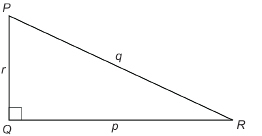Module 7
1. Module 7
1.24. Page 2
Module 7: Trigonometry
Get Started
In this activity you will review the relationship between the two acute angles of a right triangle.
 Self-Check
Self-Check
Work with a partner, if possible.
Step 1: Use your protractor and straight edge to draw a right triangle PQR of any size. An example is shown below.

Step 2: Measure ∠P and ∠R to the nearest degree.
Did You Know
The letters used to name triangles are usually placed alphabetically. But the letters really can be in any order. For example, the previous triangle could have been named any of the following: ΔQRP, ΔPRQ, or ΔRQP.
SC 1. Determine ∠P + ∠R.
SC 2. Will the sum of the two acute angles of a right triangle always be the same as the answer you obtained in SC 1? Explain.
SC 3. What name is given to a pair of angles with this sum?
SC 4. In right ΔABC, ∠A and ∠B are acute angles. If ∠B = 47°, what is the size of ∠A? Draw a diagram to support your answer.
SC 5. What is the complement of a 60° angle?